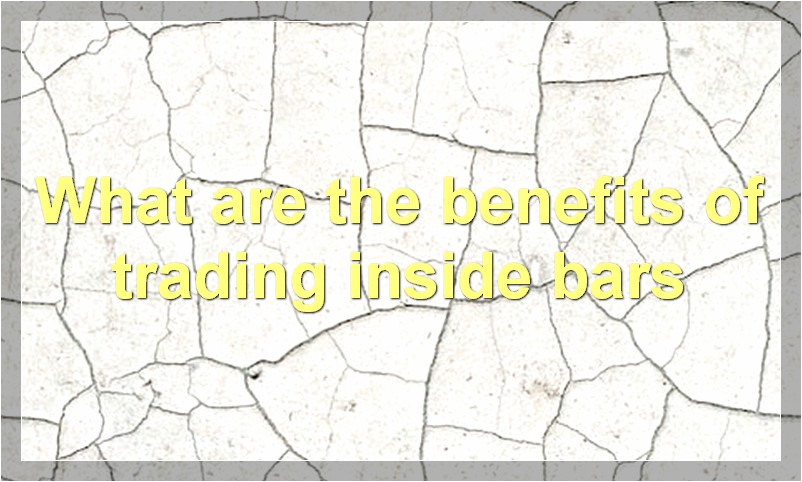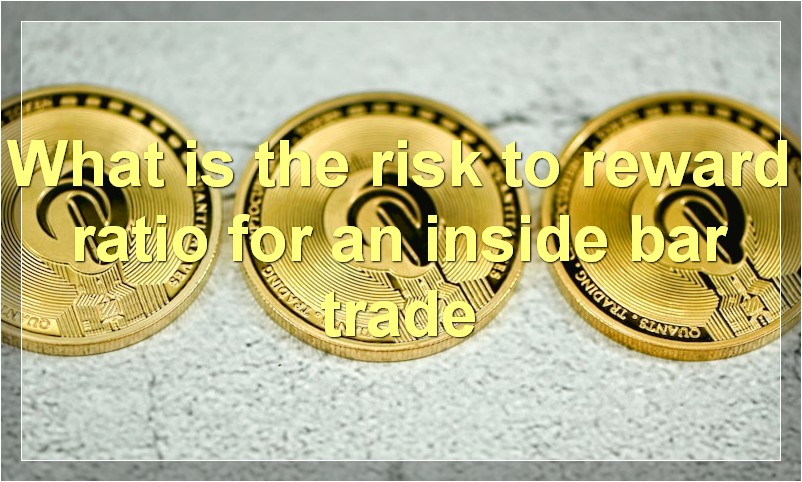The inside bar trade is a popular strategy among Forex traders, but it’s important to understand the risks and benefits before using it.
What is an inside bar trade
An inside bar is a two-bar pattern in which the second bar’s range is completely within the first bar’s range. The inside bar signals a period of consolidation or indecision and can be used to anticipate a breakout move.
The inside bar pattern occurs when the market consolidates after a directional move. It is important to note that an inside bar can form on any timeframe, but it is most often used on daily charts.
The inside bar is considered a neutral pattern, but it can be used to anticipate a bullish or bearish move. A bullish breakout from an inside bar pattern occurs when price breaks above the high of the inside bar. This move indicates that buyers are in control and that the market is likely to continue moving higher.
A bearish breakout from an inside bar pattern occurs when price breaks below the low of the inside bar. This move indicates that sellers are in control and that the market is likely to continue moving lower.
The inside bar pattern is a useful tool for traders because it can provide clues about the direction of the market. However, it is important to wait for a breakout before taking a position. This will help you avoid false breakouts and getting caught in a losing trade.
What are the benefits of trading inside bars

An inside bar is a bar that has a lower high and a higher low than the previous bar. Inside bars typically indicate a period of consolidation or indecision.
Trading inside bars can be a useful way to trade breakouts. When an inside bar forms after a period of consolidation, it often signals that the market is about to make a move. If the market breaks out above the high of the inside bar, it can be a signal to buy. If the market breaks out below the low of the inside bar, it can be a signal to sell.
One benefit of trading inside bars is that it can help you to stay disciplined. When trading breakouts, it is easy to get caught up in the excitement and enter too early or exit too late. Trading inside bars can help you to wait for a clear breakout before entering a trade.
Another benefit of trading inside bars is that it can help you to manage your risk. When trading breakouts, you are often risking a large amount of money on each trade. If the market doesn’t move in your favor, you can quickly lose a lot of money. However, when you trade inside bars, you can often put stop-loss orders close to the highs or lows of the inside bar. This can help you to limit your risk if the market doesn’t move in your favor.
How can I identify an inside bar setup
An inside bar is a candlestick with a smaller range than the previous candlestick. It is considered a continuation signal, as it often occurs within a trend. The inside bar indicates a pause in the current trend, as bulls and bears battle for control.
To identify an inside bar setup, look for a candlestick with a small range that is within the range of the previous candlestick. The inside bar should have a higher low and lower high than the previous candlestick. This signals that the current trend is pausing and that there is indecision among market participants.
If you see an inside bar setup on a chart, pay attention to the direction of the previous trend. If the inside bar forms during an uptrend, it signals a potential reversal. If the inside bar forms during a downtrend, it signals a potential continuation of the current trend.
When trading inside bars, be sure to place your stop loss above or below the mother bar (the previous candlestick). This will help you avoid getting caught in false breakouts.
What is the difference between an inside bar and a bearish/bullish engulfing pattern
An inside bar is a candlestick pattern that occurs when the range of the candlestick for that day “hugs” or is inside of the range of the prior day’s candlestick. An inside bar can be either bullish or bearish, depending on the market conditions and the preceding price action. A bearish engulfing pattern is a candlestick pattern that occurs when a small white candlestick is engulfed by a large black candlestick. This pattern typically forms during a downtrend and signals a continuation of the trend. A bullish engulfing pattern is the opposite, with a small black candlestick being engulfed by a large white candlestick. This pattern typically forms during an uptrend and signals a continuation of the trend.
Is it better to trade inside bars on the daily or 4hr timeframe
The answer to this question is not straightforward, as it depends on a number of factors. In general, however, trading inside bars on the daily timeframe tends to be more reliable than on the 4hr timeframe. This is because the daily timeframe provides more data for the market to digest, resulting in cleaner price action and thus more accurate signals. Additionally, the daily timeframe is less prone to false breakouts, which can occur frequently on the 4hr timeframe.
What is the risk to reward ratio for an inside bar trade

The risk to reward ratio for an inside bar trade is often considered to be very favorable. The main reason for this is that the stop loss is relatively small, while the potential profit is large. Essentially, the inside bar represents a consolidation period, during which the market is undecided about which direction it wants to go. When the market finally breaks out of this consolidation, it often does so with a strong move in one direction or the other. This means that there is a good chance that the market will move in your favor once you enter your trade. While there is no guarantee that this will happen, the odds are generally in your favor when trading inside bars.
Where is the stop loss placed for an inside bar trade
An inside bar trade is a type of trade where the stop loss is placed within the previous bar’s range. This means that if the market moves against you, your losses will be limited to the size of the previous bar. Many traders use this type of trade to take advantage of small changes in market direction.
Can I trade inside bars on any timeframe
Yes, you can trade inside bars on any timeframe. However, the most important thing is to make sure that you are trading on a timeframe that is appropriate for the market conditions. For example, if you are trading in a very volatile market, you may want to consider using a shorter timeframe so that you can get in and out of your trades quickly. On the other hand, if you are trading in a more subdued market, you may want to use a longer timeframe so that you can take advantage of the longer-term trend.
What are some common pitfalls when trading inside bars
There are a few common pitfalls that traders should be aware of when trading inside bars. First, many inside bars form on the back of a strong move and as such, they can be difficult to trade. Second, inside bars often occur at key levels of support and resistance and can be difficult to trade without a clear bias. Finally, inside bars can be tricky to trade if the market is ranging, as it can be difficult to know when to enter and exit a trade.
Are there any special considerations when trading inside bars in a trending market
An inside bar is a candlestick with a lower high and higher low than the previous candlestick. Inside bars typically indicate a period of consolidation or indecision. Trading inside bars in a trending market can be tricky because it’s often difficult to determine which way the market will breakout. If the market is in an uptrend, you may want to wait for an inside bar to form on the pullback before buying. If the market is in a downtrend, you could look to sell short after an inside bar forms on the rally.

